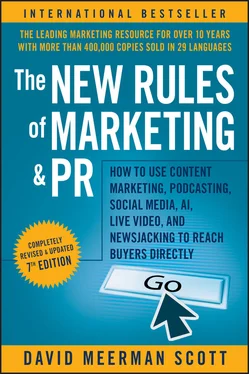1 ...8 9 10 12 13 14 ...24 1 1 ford.com
2 2 dodge.com
3 3 forums.edmunds.com
4 4 sethgodin.typepad.com/seths_blog/2006/01/nonlinear_media.html
2 The New Rules of Marketing and PR
My wife, Yukari, was checking out her Twitter stream one day and noticed that someone she follows tweeted about Hotel & Igloo Village Kakslauttanen. 1Yukari clicked the link and learned that the resort is located in the Saariselkä Fell area of Lapland in northern Finland. In winter, you can stay there in a private glass igloo, which means that from bed you can check out the stars (or, if you are lucky, the aurora borealis). She found this terribly exciting, so she tweeted a response from her Twitter ID, @yukariwatanabe: “I want to go there!”
We discussed the resort that evening over dinner. Why not go? Our daughter was off to university, so we had the time. The next day we booked the trip for several months later. Done deal.
Now, I know that a winter vacation above the Arctic Circle might seem like a punch line to a bad joke. Heck, the sun didn’t even rise when we were there in mid-December (the “day” consists of just four hours of twilight at that time of year). But for us it seemed perfect, because we’ve traveled all over the world and are always looking for unusual adventures.
How did we know that we wanted to go? By the resort’s website, of course. The site lists all sorts of winter activities for guests. When I saw “Husky Sledding Safari,” I was ready to pack my bags (bucket list . . .). But Yukari wanted to do a little more checking, so she Googled the resort, looked at the reviews on TripAdvisor, and also read about it in a New York Times article.
Everybody I know has a story like this. Somebody makes a comment via a social network site. It leads someone else to a website where the content educates and informs. And that person ends up becoming a customer of a company that he or she had never heard of moments before. We’re living in a new world of marketing and PR.
If you are the seller in this transaction, it all comes down to content: What are you creating, compared to what others are saying about you?
You’re in control. You create the content. You bring in the business.
Our time in Lapland was amazing. We had all kinds of wonderful adventures. The dogsledding was especially fun, because I got to drive (well, more like hang on). And we never would have had this amazing experience if the Hotel & Igloo Village Kakslauttanen only marketed their property using the old rules. We never would have heard about it.
The Most Important Communications Revolution in Human History
I’d like to step way back and look at the big picture. This is not a view, to use the cliché, from 30,000 feet. It’s more like the view from the moon. The new rules of marketing and public relations are part of the much bigger and more important communications revolution we’re currently living through—the most important communications revolution in human history.
Johannes Gutenberg’s invention of printing with mechanical movable type (circa 1439) was the second most important communications breakthrough in history. It meant books could be mass-produced, rather than painstakingly copied by hand. It meant ordinary people could refer to things in books, like laws. These used to have to be committed to memory.
The printing press created the first important communications revolution by freeing people’s minds from memorization and allowing them to use that extra brainpower to be creative. At the same time, this first communications revolution (which took many decades) helped large numbers of people become literate and raised living standards along the way. It brought humanity out of the medieval period and into the Renaissance.
Some 556 years later, in 1995, an even more important communications revolution began. I choose 1995 because it was the year that Netscape went public on the success of Netscape Navigator, the first popular product to allow easy web browsing.
We’re fortunate to be living in this time in history, the time of another important communications revolution. I figure we’re about halfway through it. The first 25 years or so were fast-paced, and things changed very quickly. Usage went from a few million people online to billions. But many organizations still aren’t communicating in real time on the web.
The next few decades will bring a continuation of the revolution. The pace of that change means that I need to update this book every few years. Soon, this seventh edition will be replaced by the eighth. And then the ninth. We need to be constantly learning and updating our skills to reach buyers as they’re looking for the products and services we sell.
Are you one of the revolutionaries? Or do you support the old regime? Are you marketing your product or service like Hotel & Igloo Village Kakslauttanen? Or are you failing to produce content that will do well in the search engines and social networks? For your sake, I hope it’s the former—or soon will be with the help of this book.
Gerard Vroomen will tell you that he is an engineer, not a marketer. He will tell you that the companies he co-founded, Cervélo Cycles 2and Open Cycle 3(aka OPEN), do not have any marketing experts. But Vroomen is wrong. Why? Because he is obsessed with the buyers of racing bikes from Cervélo and mountain bikes from OPEN. And he’s obsessed with the engineering-driven products he offers them.
Cervélo Cycles, which Vroomen sold in 2011 but for which he remains an advisor, is a Canadian manufacturer of racing bicycle frames. He focused Cervélo to help his customers win races—and they do. In the 2005 Tour de France, David Zabriskie rode the fastest time trial in the race’s history on a Cervélo P3C at an average speed of 54.676 kph (33.954 mph). The winner of the 2008 Tour de France, Carlos Sastre, did so on a Cervélo. And at the three most recent Olympics, Cervélo bikes were ridden by dozens of athletes, resulting in multiple gold, silver, and bronze medals. Besides building excellent bikes, Vroomen also excels at using the web to tell cycling enthusiasts compelling stories, to educate them, to engage them in conversation, and to entertain them. Vroomen is a terrific marketer because he uses web content in interesting ways and sells a bunch of bikes in the process.
“In marketing, if the point is for our company to get noticed, we can’t do it the same as everybody else,” Vroomen says. “A big part of that is to do something unexpected and being remarkable. For example, we were the first to blog at the Tour de France and the first to do video there.”
The Cervélo site works extremely well because it includes perfect content for visitors who are ready to buy a bike and also for people who are just browsing. The content is valuable and authentic compared to the marketing messages that appear on so many other sites. “Our goal is education,” Vroomen says. “We have a technical product, and we’re the most engineering-driven company in the industry. Most bike companies don’t employ a single engineer, and Cervélo has eight. So we want to have that engineering focus stand out with the content on the site. We don’t sell on the newest paint job. So on the site, we’re not spending our time creating fluff. Instead, we have a good set of content.”
Ryan Patch is an amateur triathlon competitor on the Vortex Racing team—just the sort of customer Cervélo wants to reach. “On the Cervélo site, I learned that Bobby Julich rides the same bike that is available to me,” Patch says. “And it’s not just that they are riding, but they are doing really well. I can see how someone won the Giro de Italia on a Cervélo. That’s mind-blowing, that I can get the same bike that the pros are riding. I can ride the same gear. Cervélo has as much street cred as you can have with shaved legs.”
Читать дальше












